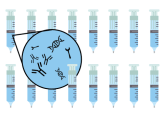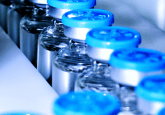6. The future of LC–MS in biologics bioanalysis

To conclude our Ask the Experts feature on biologics by LC–MS, we find out what the experts think the future holds for the use of LC–MS in biologics bioanalysis.
What kind of developments do you expect to see in the next 5–10 years regarding the quantitation of biologics by LC–MS?
Chad Christianson (Alturas Analytics)
One drawback of analyzing digested peptide sequences by LC–MS is that the state of the intact biologic is unknown. Since only a small fragment of the molecule is being analyzed, the biologic degrading in the matrix may not be observed. The capability of analyzing an intact biologic with the accuracy, precision and sensitivity of a triple quadrupole mass spectrometer is a necessity. Within the next decade, technological improvements of high-resolution mass spectrometers should make them more sensitive, accurate and precise for these intact biologics. The analysis of biologics by high-resolution mass spectrometers should become the preferred method of instrumental analysis.
Matthew Ewles (Covance)
I would expect to start seeing high resolution mass spectrometry starting to make greater inroads into quantitative bioanalysis for biologics. Although this has been talked about extensively for well over a decade, I have started to see real movement in this area over the last few years. It is also clear that demand for LC–MS/MS support for biologics is going to increase, as biologics become more ‘novel’, for example, fusion proteins, peptide/oligo conjugates andprotein-small molecule conjugates. Many of these molecules will require quite custom considerations for their bioanalysis (the question of ‘what to measure’ will become a difficult one) and LC–MS/MS complementing ligand-binding assays seems set to become the gold standard. These increasing complex molecules will require an increasingly diverse toolbox to measure them!
Wenying Jian (Janssen Research & Development)
I expect to see LC–MS being increasingly routinely used for bioanalysis of biologics and the data being more readily accepted by regulatory agencies. Very importantly, as biologics with increasingly complicated structures are being developed, the bioanalysis community are expected to accumulate more knowledge and experience in understanding in vivo biotransformation of proteins and its impact and implication on bioanalysis. In terms of workflow, I am hoping to see further improvement in assay efficiency as a result of advancements in automated assay systems and rapid digestion products. I would also like to see advancement in instrumentation on micro-flow LC and mass spectrometry for better sensitivity and in software for more efficient data processing and regulatory compliance, particularly for top-down intact analysis. Other areas where we are looking forward to seeing progresses are tissue sample analysis of biologics by approaches such as mass spec imaging and analysis in formalin-fixed paraffin-embedded samples for better understanding of drug exposure at the target site.
Carsten Krantz (Novartis)
Biologics by LC–MS/MS will gain more momentum in future and will likely be an alternative to ligand binding assays. With more selective column materials and automatized workflows, 2D separation-based methods will facilitate peptide purification leading to enhanced selectivity and sensitivity. Ion mobility will also get more traction in regulated bioanalysis for large molecules and routinely be used as an extra dimension in cases where additional separation is needed. We see already that many CROs have become accustomed to biologics byLC–MS and their experience with technology and automation together with more sophisticated requests from the pharmaceutical industry will drive the development of robust and sustainable protein quantitation workflows in the regulated environment. On the detector side, I can imagine that mass spectrometers will get more sensitive and we will see high-resolution LC–MS applied routinely. Top-down approaches are already used in the discovery space and will be introduced in the regulated pre-clinical and clinical environment providing quantitative and qualitative attributes. The pharmaceutical industry is developing more and more complex molecules with many different modalities. To understand the behavior of these molecules sensitive in vivo descriptions of their pharmacokinetics as well as structural characterization of catabolites and metabolites will be essential.
Keeley Murphy (Thermo Fisher Scientific)
Over the next 5–10 years I would expect to see next generation LC–MS systems continue to improve in both low level detection capability and overall resolving power when applied to the quantification of biologics. Bench top mass spectrometers capable of ultrahigh resolution in excess of 1,000,000 resolving power have been previously demonstrated, providing baseline separation of isotopes for ~80 kDa proteins at the intact level. Additionally, in-line immunocapture and low flow chromatography are being implemented more routinely, demonstrating the potential for automated and effective tools for streamlining these hybrid techniques that dramatically impact overall assay performance. These types of advances focused around sensitivity and resolving power coupled with improvement to chromatographic solutions for large proteins, including improved source introduction at low solvent flow rates, will continue to push the analytical boundaries used to support research and innovation for biologic drug development.
The opinions expressed in this feature are those of the authors and do not necessarily reflect the views of Bioanalysis Zone or Future Science Group.







